Emulsified isoflurane postconditioning produces cardioprotection against myocardial ischemia-reperfusion injury in rats
- PMID: 23625523
- PMCID: PMC10717228
- DOI: 10.1007/s12576-013-0261-z
Emulsified isoflurane postconditioning produces cardioprotection against myocardial ischemia-reperfusion injury in rats
Abstract
Emulsified isoflurane (EIso) preconditioning can induce cardioprotection. We investigated whether EIso application after ischemia protects hearts against reperfusion injury and whether it is mediated by the inhibition of apoptosis. Rats were subjected to 30-min coronary occlusion followed by 180-min reperfusion. At the onset of reperfusion, rats were intravenously administered saline (sham, control group), 30 % intralipid (IL group) or 2 ml kg(-1) EIso (EIso group) for 30 min. After reperfusion, infarct sizes, myocardial apoptosis and expression of Bcl-2, Bax and caspase-3 proteins were determined. Hemodynamic parameters were not different among groups. Compared with control and intralipid group, EIso limited infarct size, inhibited apoptosis, increased the expression of Bcl-2, decreased the expression of Bax, cleaved caspase-3, and enhanced Bcl-2/Bax ratio. EIso protects hearts against reperfusion injury when administered at the onset of reperfusion, which may be mediated by the inhibition of apoptosis via modulation of the expression of pro- and anti-apoptotic proteins.
Conflict of interest statement
The authors declare that they have no conflict of interest.
Figures
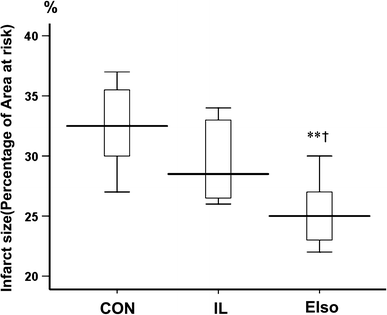
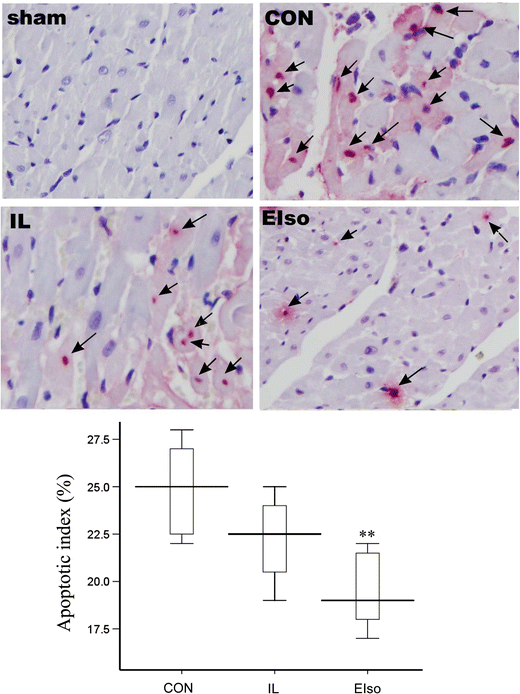
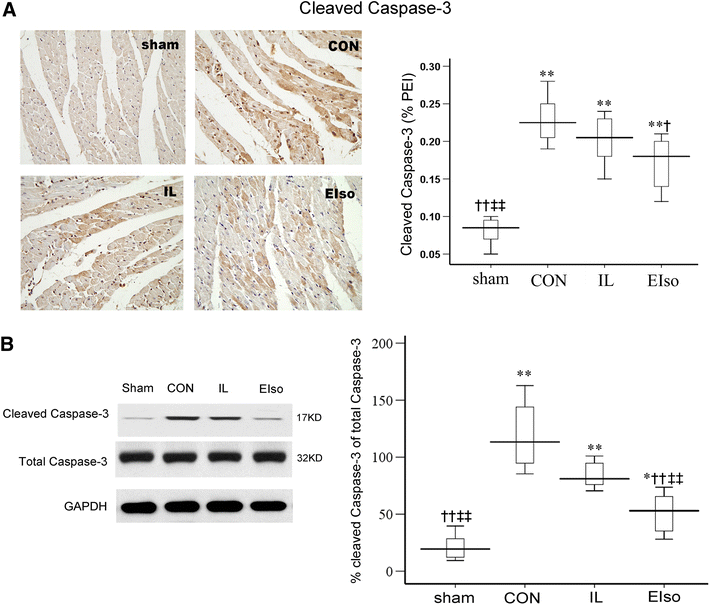
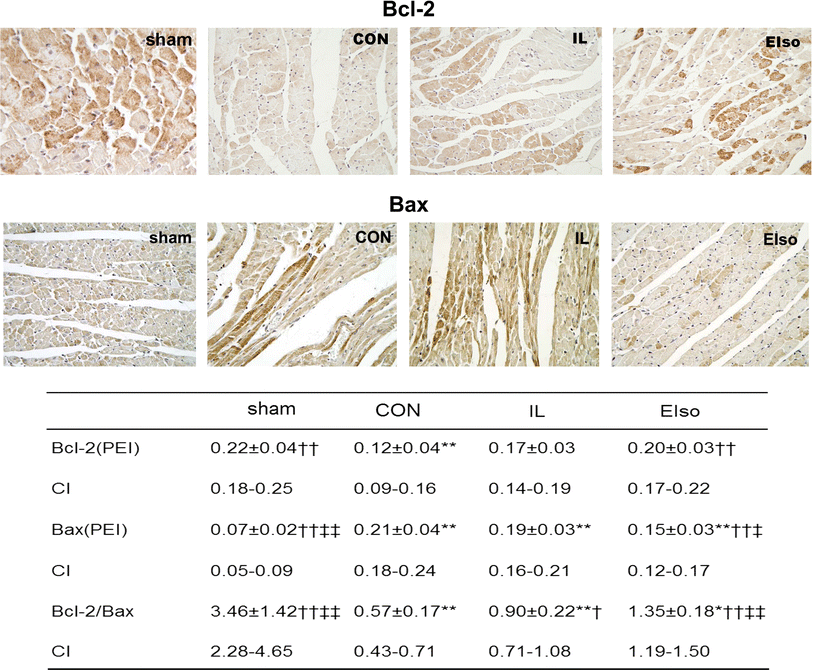
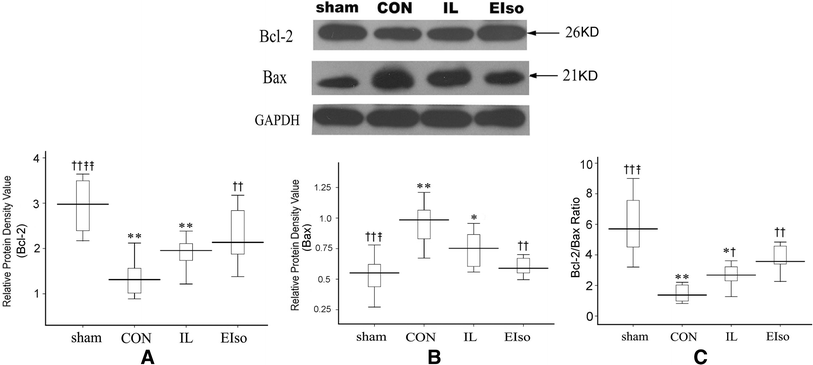
Similar articles
-
Intravenous pretreatment with emulsified isoflurane preconditioning protects kidneys against ischemia/reperfusion injury in rats.BMC Anesthesiol. 2014 Apr 16;14:28. doi: 10.1186/1471-2253-14-28. eCollection 2014. BMC Anesthesiol. 2014. PMID: 24739487 Free PMC article.
-
Emulsified isoflurane protects rat heart in situ after regional ischemia and reperfusion.Fundam Clin Pharmacol. 2014 Apr;28(2):190-8. doi: 10.1111/fcp.12030. Epub 2013 Apr 21. Fundam Clin Pharmacol. 2014. PMID: 23600699
-
Effects of emulsified isoflurane on haemodynamics and cardiomyocyte apoptosis in rats with myocardial ischaemia.Clin Exp Pharmacol Physiol. 2009 Aug;36(8):776-83. doi: 10.1111/j.1440-1681.2009.05138.x. Epub 2009 Jan 17. Clin Exp Pharmacol Physiol. 2009. PMID: 19207725
-
The protective effects of emulsified isoflurane on myocardial ischemia and reperfusion injury in rats.Can J Anaesth. 2009 Feb;56(2):115-25. doi: 10.1007/s12630-008-9016-3. Epub 2008 Dec 31. Can J Anaesth. 2009. PMID: 19247759
-
Sevoflurane postconditioning reduces myocardial reperfusion injury in rat isolated hearts via activation of PI3K/Akt signaling and modulation of Bcl-2 family proteins.J Zhejiang Univ Sci B. 2010 Sep;11(9):661-72. doi: 10.1631/jzus.B1000155. J Zhejiang Univ Sci B. 2010. PMID: 20803770 Free PMC article.
Cited by
-
Irisin Attenuates Myocardial Ischemia/Reperfusion Injury and Improves Mitochondrial Function Through AMPK Pathway in Diabetic Mice.Front Pharmacol. 2020 Sep 11;11:565160. doi: 10.3389/fphar.2020.565160. eCollection 2020. Front Pharmacol. 2020. PMID: 33013403 Free PMC article.
-
Contribution of apoptosis in myocardial reperfusion injury and loss of cardioprotection in diabetes mellitus.J Physiol Sci. 2015 May;65(3):201-15. doi: 10.1007/s12576-015-0365-8. Epub 2015 Mar 1. J Physiol Sci. 2015. PMID: 25726180 Free PMC article. Review.
-
Intravenous pretreatment with emulsified isoflurane preconditioning protects kidneys against ischemia/reperfusion injury in rats.BMC Anesthesiol. 2014 Apr 16;14:28. doi: 10.1186/1471-2253-14-28. eCollection 2014. BMC Anesthesiol. 2014. PMID: 24739487 Free PMC article.
-
Emulsified isoflurane combined with therapeutic hypothermia improves survival and neurological outcomes in a rat model of cardiac arrest.Exp Ther Med. 2017 Mar;13(3):891-898. doi: 10.3892/etm.2017.4044. Epub 2017 Jan 13. Exp Ther Med. 2017. PMID: 28450915 Free PMC article.
-
The Bioequivalence of Emulsified Isoflurane With a New Formulation of Emulsion: A Single-Center, Single-Dose, Double-Blinded, Randomized, Two-Period Crossover Study.Front Pharmacol. 2021 Mar 10;12:626307. doi: 10.3389/fphar.2021.626307. eCollection 2021. Front Pharmacol. 2021. PMID: 33776768 Free PMC article.
References
Publication types
MeSH terms
Substances
LinkOut - more resources
Full Text Sources
Other Literature Sources
Research Materials

